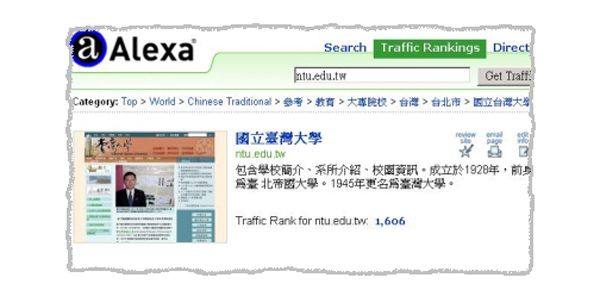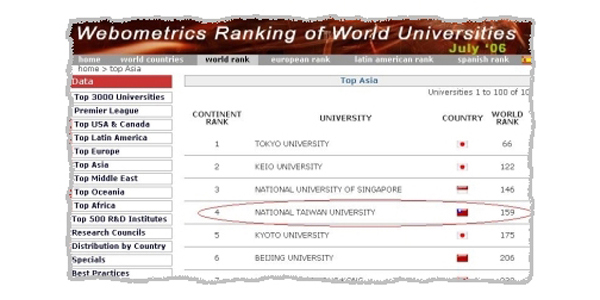| |
 |
|
|
 |
| |
 |
|
|
::: NYU's Official Website Ranks among the Top 100 Hot Websites in Taiwan,159th in Global College Websites, and 4th in Asia
|
National Taiwan University's official website has been selected by "Digital Age" magazine as No. 72 of Taiwan's 100 top ranking hot websites in January 2007, and also ranks 4th in all college websites of Asian countries, next only to Tokyo University and Keio University of Japan, and the University of Singapore. In Digital Age's appraisal of Taiwan's university websites, NTU won first place, a feat which fully attests to the academic influence and popularity of NTU.
In January, 2007, the official website of National Taiwan University was selected by "Digital Age" magazine as No. 72 of the top ranking 100 websites in Taiwan, a feat that bespoke of the academic influence and popularity of Taiwan's best university.
In July of 2006, the international ly renown ed institute for
website quantitative analysis Webometrics ( http://webometrics.info/index.html )
conducted a survey of the websites of 3000 universities in the world, using the number of webpages,
number of hyperlinks, number of files (including pdf, ps, doc, ppt, etc) and number of search es
using Google, Scholar as the criteria for evaluation.

The traffic on NTU's official website ranks 1606 th in the world. (source: http://www.alexa.com/data/details/main?q=&url=ntu.edu.tw )

In the survey conducted by Webometrics, NTU's official website ranks 159 th in the world, and 4 th in Asia. (source1: http://www.webometrics.info/top100_continent.asp?cont=asia) Webometrics is published by the Laboratorio de Internet, a subsidiary institute of the Center for Scientific Information and Documentation of Spain, which in turn falls under the jurisdiction of of the Spanish National Science Council. The newly published rankings of the university websites in the world was assessed by the number of web publications and the frequency of web documents being cited. The survey put great emphasis on the information power of universitys' websites.
(source2: http://beta.roc-taiwan.org/ct.asp?xItem=15547&ctNode=3187&mp=102,
Taiwan's Representative office in Belgium and the Europe Union)
|
|
Since 1980, Taiwan has gradually followed the footsteps of the United States and Japan to become one of the world's bases for quartz crystal oscillator industries. However this growth did not accompany a solid understanding of crystal vibration theory and analysis. In 1994, Professor Wu first established Surface Acoustic Wave Study and related advanced core technologies while successfully applying a self-developed SAW different frequency dispersion analysis to the piezoelectric layer diamond surface acoustic wave filter design. This distinguished Professor Wu's lab as the only laboratory in Asia, except Sumimoto Electronics in Japan, with this capability it auspices laboratory in Asia. A joint R&D venture with industry partners in 2000 resulted in the quartz crystal oscillator industry stepping into the high end world of SAW filter production. In addition to the acoustic filter Study, Professor Wu's surface acoustic wave components exhibit both academic and practical values when extended to biomedical inspections and control of micro-fluid applications.
Similar to the phenomenon of band gap exhibited by photonic crystals, cyclical elastic materials can also form phononic crystals and produce a band-gap for elastic vibrations (including acoustic bibrations). This band gap prevents the phonon transmission for specific incident angles and frequencies, forming a transformation effect for filter waves and elastic waves (P-wave. S-wave and SAW). Professor Wu began studying phononic crystals in 2000, establishing the theory to analyze SAW within highly anisotropic or piezoelectric phonoic crystals. Furthermore, he was the first to combine micrometer level phononic crystal production and layered RF surface acoustic wave components to successfully measure and confirm the existence of micrometer level crystal surface acoustic wave band gap. This is a key result in the development of phononic crystals in LSI technology for micro-acoustic channel and broadband filters.
Lee Chih-Kung, a joint professor with the Department of Engineering Science and the Department of Ocean Engineering, was also selected as a 2006 Fellow for the American Society of Mechanical Engineers. His research results include new piezoelectric sensor elements, piezoelectric transformers, surface plasma resonance and sub-wavelength nano-structure interaction with the laser, a lipid that could dissolve or render harmless such deadly viruses such as SARS or avian flu virus, blood analysis equipment based on Electrochemical theory, etc. Any one of these research areas can break some bottlenecks in global fundamental research. For example, by developing a new piezoelectric transformer power supply system from the systems integration perspective, Professor Lee has completed the development multiple new techniques capable of breaking through patent barriers in several countries, including a single piezoelectric transformer system integration technique. This technology has the potential to significantly improve the competitiveness of Taiwan's computer screen light source. Because of these research and development results, Professor Lee and his research team have won several domestic and international awards.
Generally speaking, Lee Chih-Kung, a professor and his team use "only do things useful to Taiwan, only do things of academic value "as a motto and created a new model of cooperation with industry partners. The research results also confirmed that only a multi-disciplinary applied science research team can create fundamentally innovative research results.
|
|
|
Copyright © 2006 National Taiwan University
No. 1, Sec. 4, Roosevelt Road, Taipei, 10617 Taiwan(R.O.C.)
Phone: +886-2-3366-3366 Fax: +886-2-2362-7651
|

